I received a 2 kg bag of Anita’s Organic Mill sprouted whole spelt last week and was excited to try working with more spelt than I have in the past. I haven’t had the best of results with spelt. As you know The gliadin/glutenin ratio is significantly higher in spelt at 3.5, than in wheat at 2. As a result spelt’s gluten is more extensible and less elastic. This typically results in spelt loaves spreading and not achieving good oven spring. That has been my experience with whole spelt. To try to counter this one can combine spelt with a stronger flour, reduce the hydration, bake in a pan or add vital wheat gluten. I’m sure there are other things one can do, but I tried three of these four things to see if I could bake a good 100% whole spelt loaf. I did alright, but think that more VWG might still be helpful.
Sweet Stiff Levain
• 53g whole spelt flour (stoneground)
• 24g water
• 18g light brown sugar
• 18g sourdough starter ~100% hydration
1:1.33:2.9:1 starter:water:flour:sugar
Tangzhong classic 1:5 ratio
• 89g milk
• 18g Whole Spelt flour (Stoneground)
Dough Dry Ingredients
• 15 g vital wheat gluten
· 424 g whole spelt four (Sprouted)
• 30 g sugar
• 7g salt 1.6%
Dough Wet Ingredients
• 180g milk (I added 181 g)
• 50g egg beaten (about 1 lg egg)
• 60g butter melted
Pre-bake Wash
• 1 egg beaten
• 1 Tbsp milk
Post-bake Wash
• 1 Tbsp butter (optional)
Instructions
Levain
Mix the levain ingredients in a jar or pyrex container with space for at least 300% growth.
Press down with your knuckles to create a uniform surface and to push out air.
At a temperature of 76ºF, it typically takes up to 10-12 hours for this sweet stiff levain to be at peak.
Tangzhong
In a sauce pan set on med-low heat, whisk the milk and flour until blended. Then cook for several minutes until thickened, stirring regularly with a spoon or heat-resistant spatula. Let cool in the pan or, for faster results, in a new bowl. Theoretically it should reach 65ºC (149ºF) but I don’t find I need to measure the temperature as this gelatinizes at this temperature.
Dough
In the bowl of a stand mixer, add the milk, egg, tangzhong, salt, sugar and levain. Mix and then break up the levain into smaller pieces. Next add the flour and vital wheat gluten. Mix on low speed and drizzle in the melted butter. Once incorporated increase the speed gradually to medium. Mix at medium until the gluten is moderately well developed, approximately 10 mins. Add the sesame seeds gradually and then continue to mix until the dough is fully developed about 10 mins. You should be able to pull a good windowpane, not quite as good as a white flour because the bran will interrupt the windowpane somewhat.
Shape the dough into a tight ball, cover in the bowl and ferment for 2.5-3.5 hours at 82ºF. There may be some rise visible at this stage.
You can next place the dough into the fridge to chill the dough for about 1.5 hours, this makes rolling the dough easier, remember if you do so they final proof will take longer. Alternatively, you can do a cold retard in the fridge overnight.
Prepare your pans by greasing them or line with parchment paper. Scrape the dough out onto a clean counter top. Lightly flour the bench. Transfer the dough onto the bench and divide it into four. I like to weigh them to have equal sized lobes. Shape each tightly into a boule, allow to rest 5 mins. Using a rolling pin roll each ball out and then letterfold. Turn 90* and using a rolling pin roll each out to at least 8”. Letterfold again from the sides so you have a long narrow dough. Then using a rolling pin, roll flatter but keeping the dough relatively narrow. The reason to so this extra letterfold is that the shorter fatter rolls when placed in the pan will not touch the sides of the pan. This allows the swirled ends to rise during final proof. Next roll each into a tight roll with some tension. Arrange the rolls of dough inside your lined pan alternating the direction of the swirls. This should allow a greater rise during proof and in the oven.
Cover and let proof for 6-8 hours, longer time if you chilled your dough for shaping. I proof until the top of the dough comes to within 1 cm of the top edge of the pan.
Preheat the oven to 350F and brush the dough with the egg-milk wash. Just prior to baking brush with the egg-milk wash again.
Bake the loaves for 50 minutes or until the internal temperature is at least 190ºF, rotating as needed to get even browning. Shield your loaf if it gets brown early in the baking process. After 50 mins remove the bread from the pan and bake a further 10 mins by placing the loaf directly in the oven on the rack with the oven turned down to 325ºF. You can brush the top of the loaf with butter if you wish at this point while the bread is still hot to keep the top crust soft.
This loaf isn’t too bad for a first try with 100% whole spelt. What do you think I can do to improve it? I’m thinking of using a bit more VWG say increase it to 20 g.
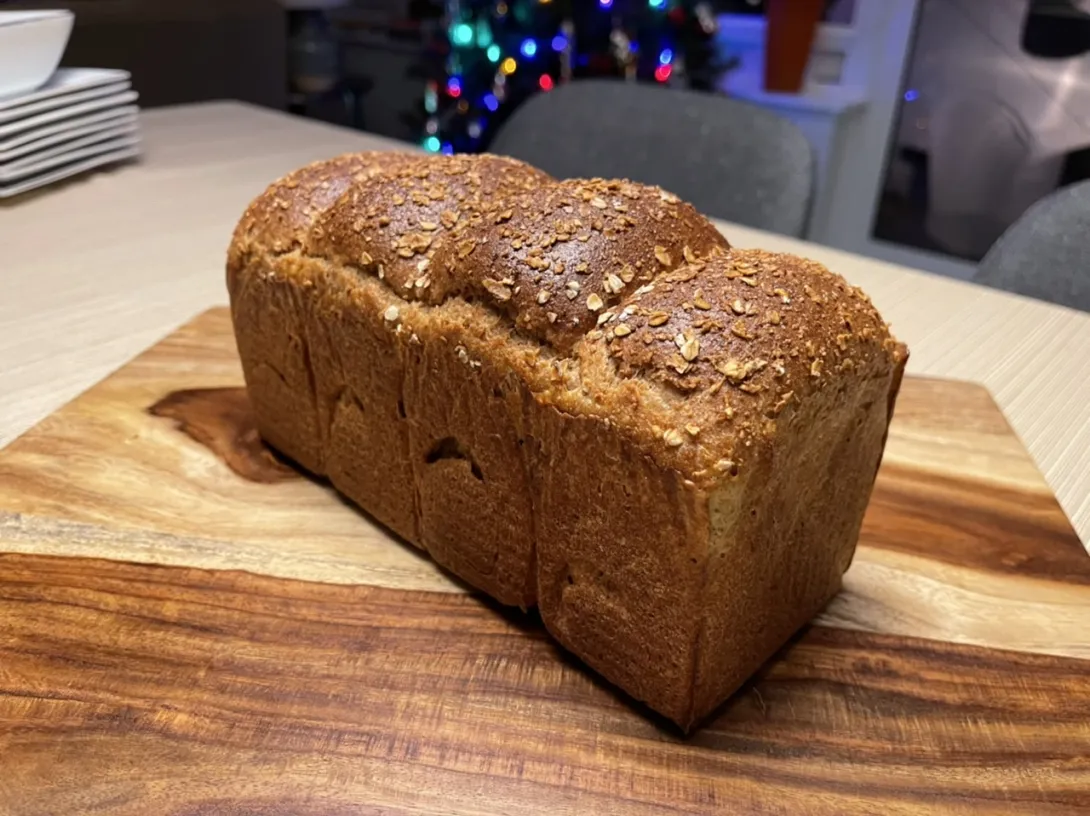
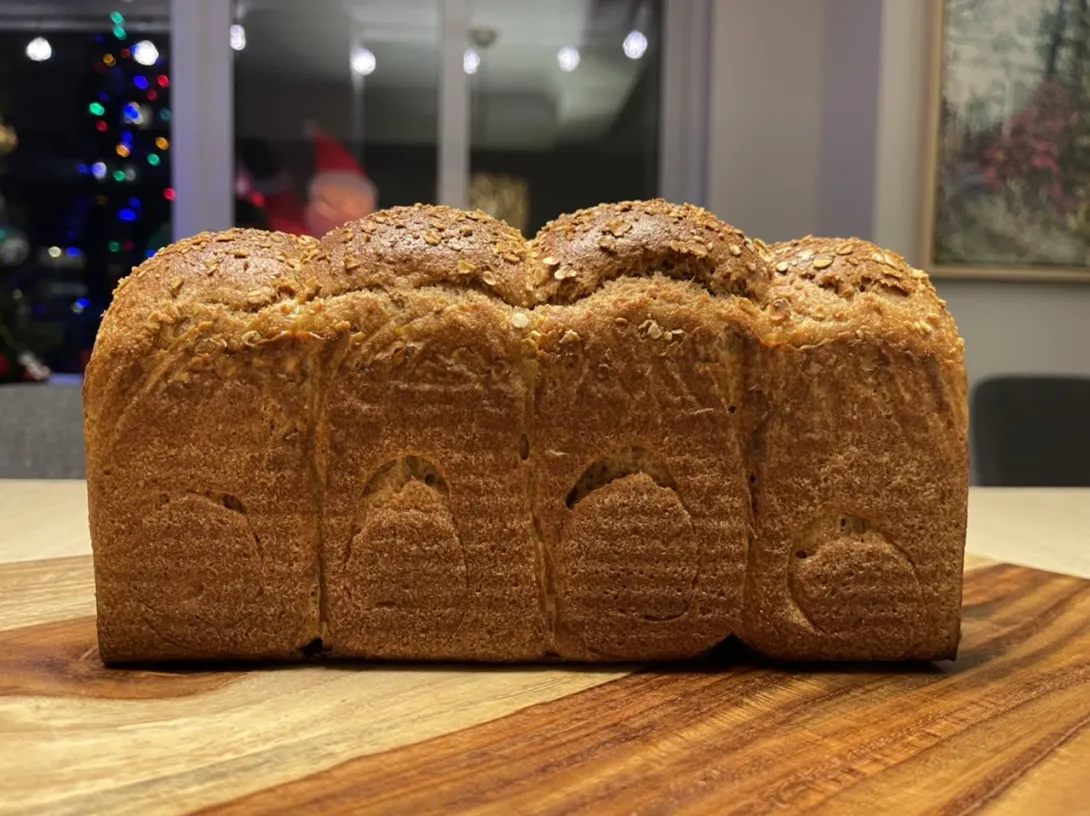
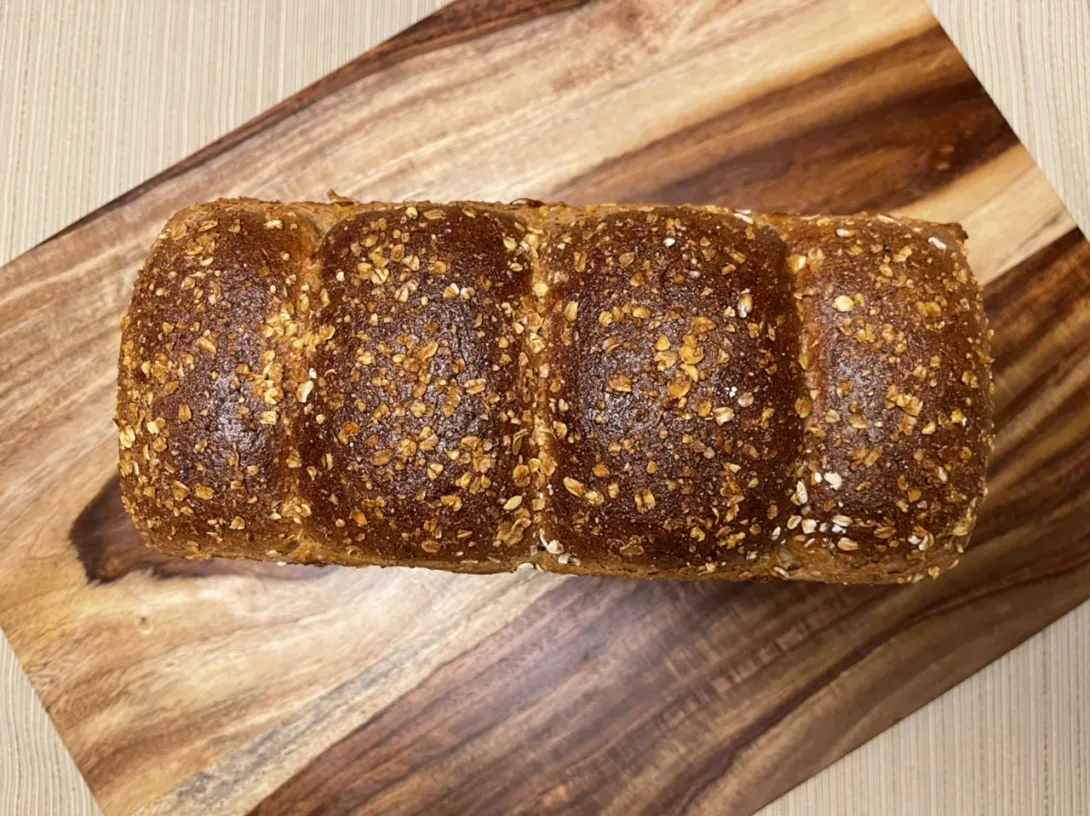
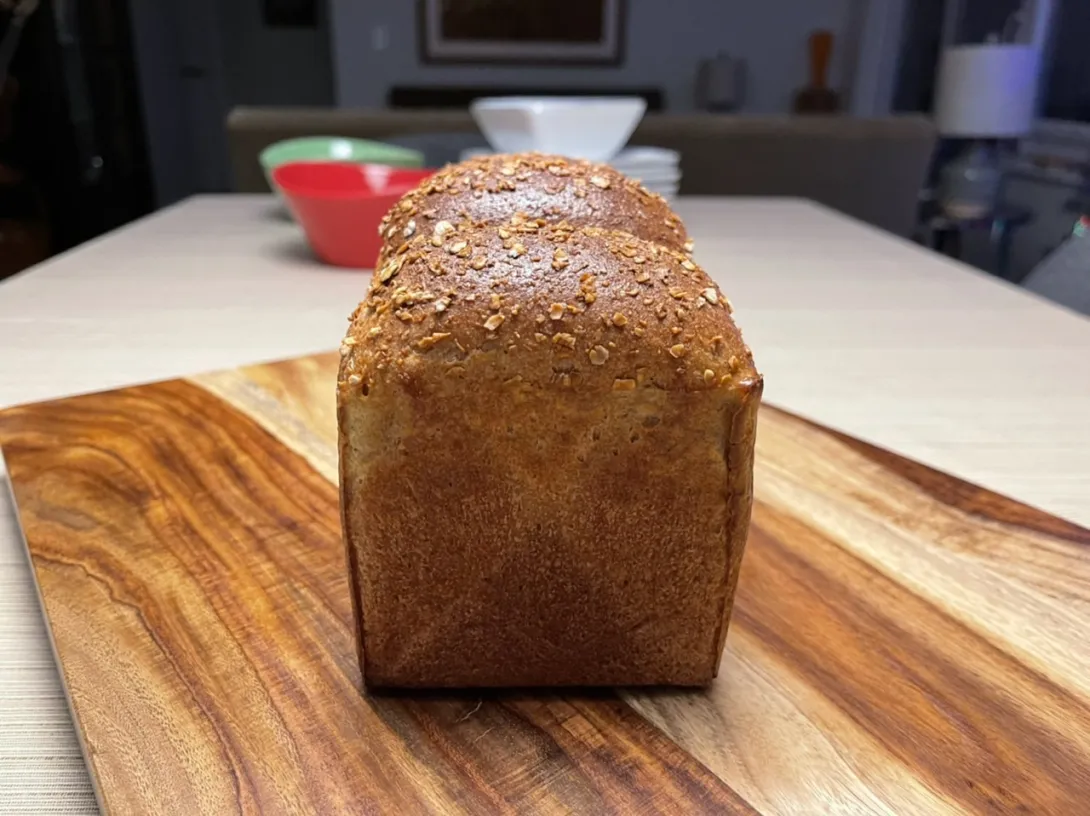
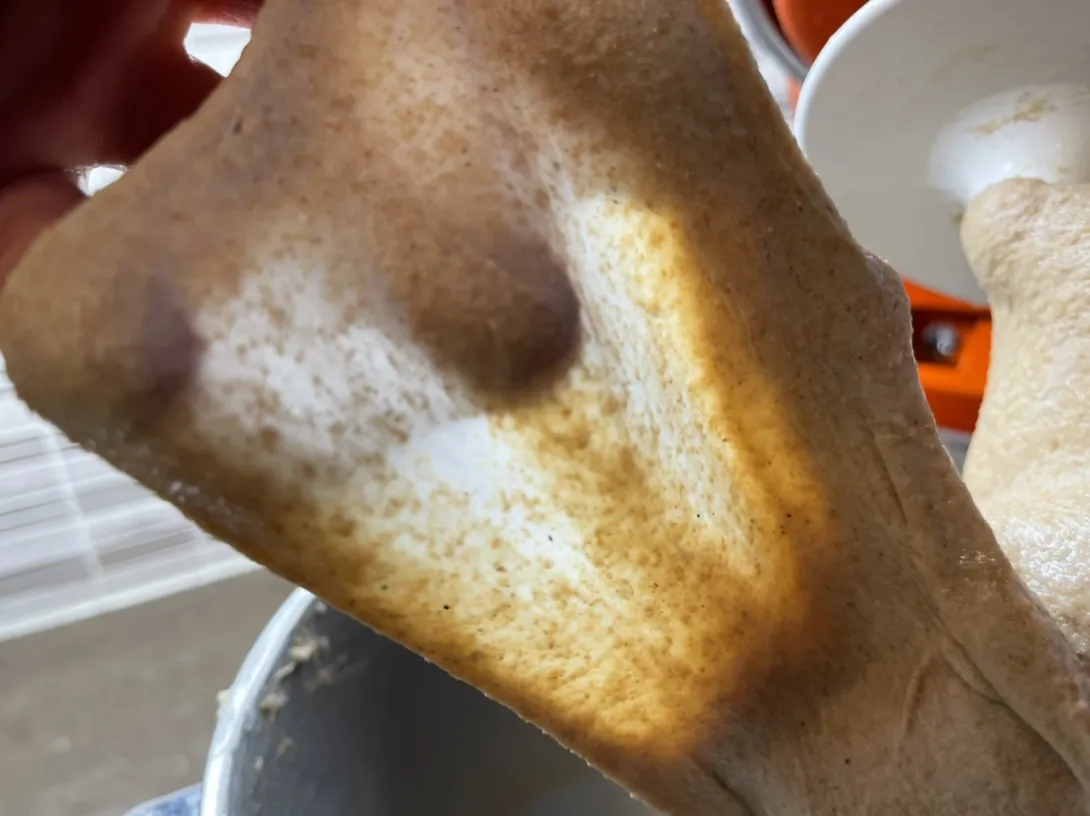
- Benito's Blog
- Log in or register to post comments
The loaf looks terrific! The most amount of whole-spelt I've used is 75%. Your formula and process are very different, also I used a pate fermentee. Your 100% spelt loaf looks well risen to me. What makes you think you need more VWG? Consider using the Pearson's Square formula to calculate the percent of VWG.
Another lovely bake, Benny.
Cheers,
Gavin
Thank you Gavin, I’d never strayed this high for spelt in the past, I’ve always been weary of it and it’s deficient gluten. I considered using a calculator for the VWG, but to make it useful one needs to know what the starting point of protein is for the flour. Because of the mismatched gliadin and glutenin, the protein levels are particularly not useful for spelt. I think I’ll just have to gradually adjust based on how each iteration bakes up. I’ll post my thoughts on the crumb soon, but the fact that the dough didn’t oven spring as much as I had expected makes me think that the gluten wasn’t quite enough.
Benny
That looks amazing, Benny! What a great result with 100% spelt, I'll be that tastes just delicious! I think I'm going to do my first attempt at your Hokkaido bread tomorrow.......I hope I can do your wonderful breads some justice!
Rich
Thanks Rich, it’s my best bake with 100% spelt, which isn’t hard since it’s my first bake with 100% spelt.
You will do great with the Hokkaido milk bread, I look forward to seeing your bake and hearing if you like the flavour. I’ve gradually adjusted the sugar in the recipe down, the lowest I’ve gone is 30 g now and there is still a hint of sweetness which I think is good for this style of bread.
Benny
I did not... this may explain all the spread on my franconia and auvergne ryes where I used milled spelt in place of the non rye flour! Thanks.
Glad I was able to share something new for you then David.
Benny
Bear with my ignorance here.
If gluten forms from gliadin + glutenin
And if spelt has too much gliadin
And if gliadin is soluble in ethanol
Would adding alcohol to the dough help at all? (or treating some of the added gluten with alcohol to boost glutenin in the ratio?)
I tried reading up in this area but just don't have the background for it. I was just wondering about changing the ratio vs. adding more gluten. I've read about it being done at an industrial level and in labs.
I believe the issue is that the ratio of gliadin to glutenin is off and that the problem is that there isn’t enough glutenin. I believe if you could add glutenin then spelt would have a better quality of gluten.
Lovely, as usual Benny.
If only I could get a taste, lots of spelt must have been very tasty.
Interesting that the spelt didn't peak as high as you normally get.
Also find that the time for the levain to peak of 10-12 hours looks quite long to me, is the sugar slowing it down?
—Jon
Thank you Jon. My thinking is that the gluten wasn’t quite enough in the dough. Thus, as the dough was rising in the oven, it wasn’t strong enough to hold in all the expanding gases in the bread and didn’t achieve the height that I usually get. The only way I’ll know for sure is to bake this again with a bit more of the VWG. I was hoping that my first attempt would be good and get me into the ballpark of how much VWG to add, and it was.
The high amount of sugar causes the microbes to dehydrate due to the osmotic pressure of the sugar. This affects both the LAB and the yeast, and in fact affects the yeast less. I’ve posted the details in another post but the pH of my sweet stiff levains drops only a small amount so you can see the LAB are affected more. You’re right, that peak of 10-12 hours is slow but expected since the yeast are slowed by the sugar’s dehydrating effects. One nice side effect of using the sweet stiff levain is that the resulting bread is less sour.
Benny
Your bread looks fantastic!!! I will try to make it with a non-dairy milk and a non dairy butter, due to my daughter is allergic to dairy. I just bought a mill to ground my flour, so I want to try to mill some spelt. Thanks for sharing! Love it!
Teresa
Hi, Teresa
You may want to give Hamelman's Honey Spelt Bread a try. No dairy in it. I stone milled the spelt for this and have had good success. It's 75% spelt and includes a pate fermentee instead of a sourdough levain. It was delicious. Here's a link to one of my previous bakes: Honey Spelt Bread | The Fresh Loaf
Gavin
Thanks so much! I will try that recipe :)
Thank you Teresa. You could easily substitute a non dairy milk and butter for the dairy in this recipe. But you could also try Gavin’s suggestion as well. Either way, good luck with your home milled spelt bread whatever you bake.
Benny